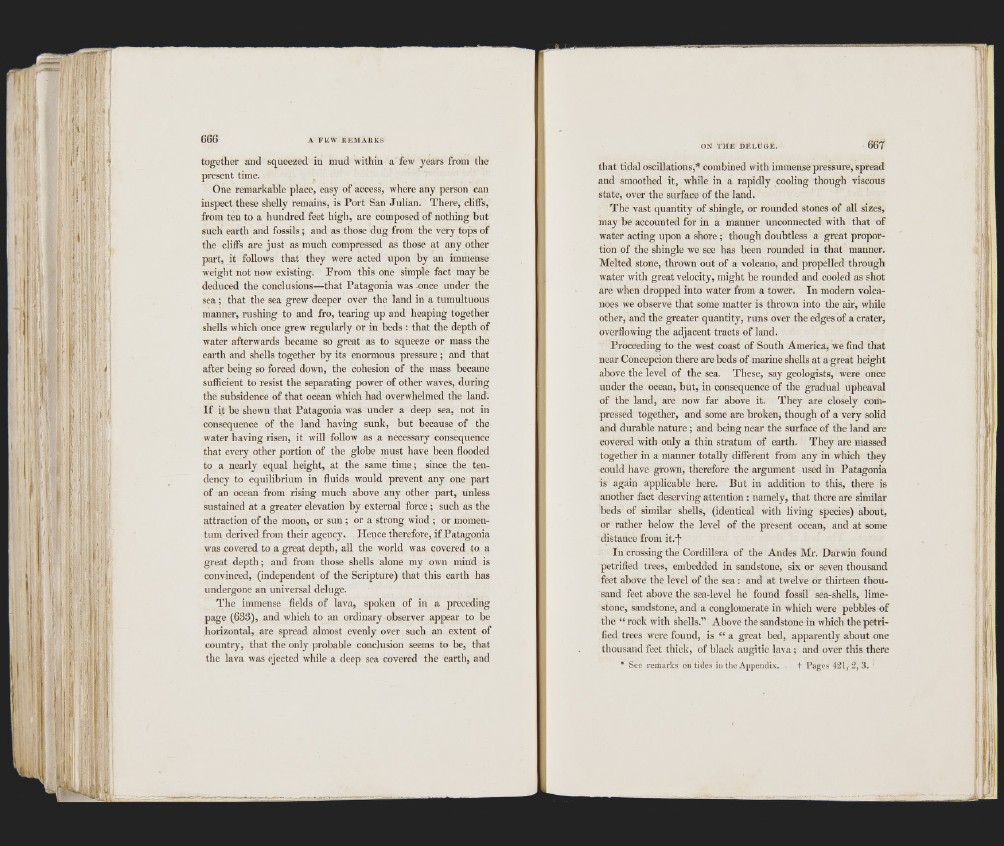
I' l -1 i J
■i I'l'
'I / 4. (jq.
r: ;i( a R
' I ' • l i '
V ! ' i • i j t t n ,
, Ui
tia
-U' ii
J !
'ii ri
’ Ml
together anti squeezed in mud within a few years from the
present time.
One remarkahle place, easy of access, where any person can
inspect these shelly remains, is Port San J ulian. There, cliffs,
from ten to a hundred feet high, are composed of nothing hut
such earth and fossils; and as those dug from the very tops of
the cliffs are just as much compressed as those at any other
part, it follows that they were acted upon hy an immense
weight not now existing. From this one simple fact may he
deduced the conclusions—that Patagonia was -once under the
sea; that the sea grew deeper over the land in a tumultuous
manner, rushing to and fro, tearing up and heaping together
shells which once grew regularly or in heds ; that the depth of
water afterwards became so great as to squeeze or mass the
earth and shells together by its enormous pressure ; and that
after being so forced down, the cohesion of the mass became
sufficient to resist the separating power of other waves, during
the subsidence of that ocean which had overwhelmed the land.
I f it be shewn that Patagonia was under a deep sea, not in
consequence of the land having sunk, but because of the
water having risen, it will follow as a necessary consequence
that every other portion of the globe must have been flooded
to a nearly equal height, at the same time; since the tendency
to equilibrium in fluids would prevent any one part
of an ocean from rising much above any other part, unless
sustained at a greater elevation by external force; such as the
attraction of the moon, or sun ; or a strong wind ; or momentum
derived from their agency, lienee therefore, if Patagonia
was covered to a great depth, all the world was covered to a
great depth; and from those shells alone my own mind is
convinced, (independent of the Scripture) that this earth has
undergone an universal deluge.
The immense fields of lava, spoken of in a preceding
page (633), and which to an ordinary observer appear to be
horizontal, are spread almost evenly over such an extent of
country, that the only probable conclusion seems to he, that
the lava was ejected while a deep sea covered the earth, and
that tidal oscillations,* combined with immense pressure, spread
and smoothed it, while in a rapidly cooling though viscous
state, over the surface of the land.
The vast quantity of shingle, or rounded stones of all sizes,
may be accounted for in a manner unconnected with that of
water acting upon a shore ; though doubtless a great proportion
of the shingle we see has been rounded in that manner.
Melted stone, thrown out of a volcano, and propelled through
water with great velocity, might be rounded and cooled as shot
are when dropped into water from a tower. In modern volcanoes
we observe that some matter is thrown into the air, while
other, and the greater quantity, runs over the edges of a crater,
overflowing the adjacent tracts of land.
Proceeding to the west coast of South America, we find that
near Concepcion there are beds of marine shells at a great height
above the level of the sea. These, say geologists, were once
under the ocean, hut, in consequence of the gradual upheaval
of the land, are now far above it. They are closely compressed
together, and some are broken, though of a very solid
and durable nature; and being near the surface of the land are
covered with only a thin stratum of earth. They are massed
together in a manner totally different from any in which they
could have grown, therefore the argument used in Patagonia
is again applicable here. But in addition to this, there is
another fact deserving attention : namely, that there are similar
beds of similar shells, (identical with living species) about,
or rather below the level of the present ocean, and at some
distance from it.#
In crossing the Cordillera of the Andes Mr. Darwin found
petrified trees, embedded in sandstone, six or seven thousand
feet above the level of the sea; and at twelve or thirteen thousand
feet above the sea-level he found fossil sea-shells, limestone,
sandstone, and a conglomerate in which were pebbles of
the “ rock with shells.” Above the sandstone in which the petrified
trees were found, is “ a great bed, apparently about one
thousand feet thick, of black augitic lava; and over this there
* See remarks on tides in the Appendix. t Pages 421, 2, 3.
J